Children play, it is a given fact. They play to discover the world around them, but also to reinvent it. Give a child a stick and he will find endless ways of reimagining its use.
Through exploration and natural curiosity children engage in spontaneous ongoing play episodes.
That is why play is so important for children’s development, especially open ended play.
What is open ended play and why is it important?
Open ended play leaves room for creativity and free interpretations as it has to end point, no given rules or stages, or well-defined process.
Think of a game of tag for example. It requires at least two players, it has certain rules which ensure that the game runs smoothly. And also, all those involved must be aware of such rules in order to participate.
Tag is NOT open ended play!
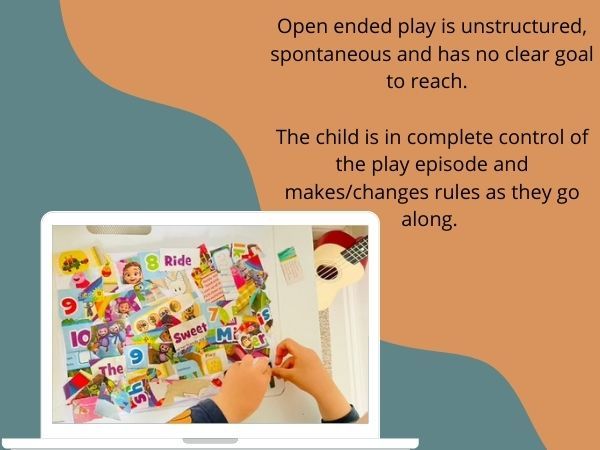
Open ended play allows players to create freely, so players are also creators. Whereas in tag they are not! When engaged in open ended play, children have endless possibilities to create. They negotiate rules and goals. So this is a great opportunity for social development as well!
Also, in open ended play children change the dynamics of the play episodes. They can speed up or slow down, change locations, materials and toys needed, change rules or set new goals.
Benefits of open ended play
There is a lot of research on the cognitive and developmental benefits of open ended play.
Firstly, research found that it supports self-regulation. Because children have choice and are offered the opportunity to structure their play as wished, they learn to exert self-control and exercise discipline. Self-regulation means setting rules and applying them to themselves. It’s not only about following rules imposed by others.
Self-regulation is only one of the researched benefits of open ended play. Other benefits refer to increasing
- vocabulary
- attention span
- communication skills
- concentration
- impulse control
- empathy
- problem-solving skills
- group participation
- curiosity
- imagination
Indoor open ended play – setting up corners
In order to encourage open ended play, make sure you provide lots of open ended materials. They will inspire different types of open ended play. You could try to set up various play corners. Some examples could be:
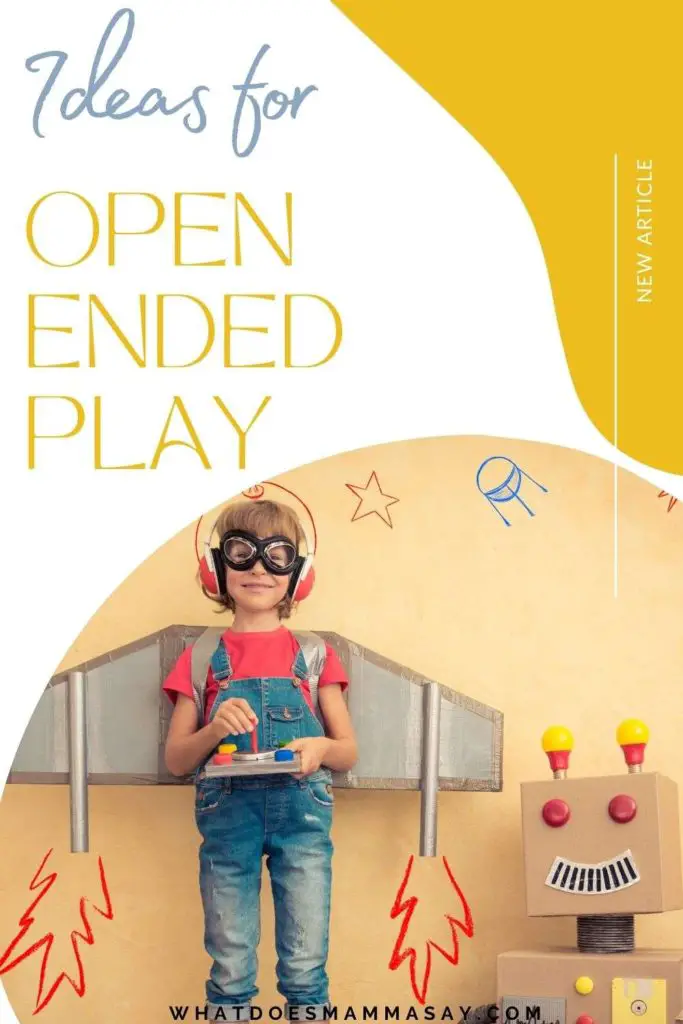
The music corner
Make a large collection of musical instruments: drums, castanets, ukulele, harmonica, flute, cymbals, maracas, xylophone, piano etc.
In the same corner, add objects children can use while making music/listening to music: dance ribbons, silk scarves, microphone etc.
Play a variety of music: jazz, blues, music from different cultures around the world and start dancing
The art corner
Offer lots of art supplies: crayons, markers, paints, chalk and different types of pencils.
Try to create a painting centre. Use a shower curtain, tape it to the floor with duct tape. Then simply let your child explore with colours and paints.
Also provide play dough, clay, modelling wax, foam etc.
Create a box of collage supplies and child-friendly glue. You could add: feathers, beads, coloured paper, magazine and newspaper pictures, wallpaper samples, cardboard, pipe cleaners etc.
The drama corner
A dress up box/trunk is very handy. Include: costumes, old clothes, hats, jewellery and accessory, blankets and scarves, neckties, gloves etc.
Provide various props: play kitchen, shop, swords and shields, doctor’s equipment, flashlights and a tent, cleaning station etc.
Make a puppet theatre using cardboard boxes.
The building corner
This building corner can include so many building materials: wooden blocks, magnetic wooden blocks, magnetic sticks etc. For a larger variety of building open ended toys go to open ended toys and materials.
Also collect lots of loose parts materials: wooden bits, cogs, cardboard tubes, sticks, pebbles and other open ended materials
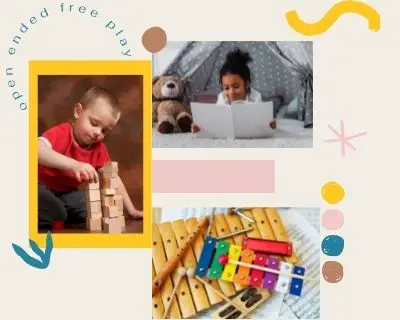
The reading corner
Set up a reading corner where children can engage with books freely. This can have a great impact on future reading practices.
I am a great supporter of shared reading. In fact, we have written quite a lot of articles on the importance of reading to children. Make sure to check out storybooks monthly recommendations for great books to read with your little ones.
To encourage reading, try to include books the children can manipulate easily. Such books need to be easy for them to read. Add nursery rhymes, rhyming picture books, quiet books, etc.
For children to be able to read and explore their books on their own, you need to read together many times. Through shared reading the child discovers what books are used for. They also learn to love books because of the bonding moment you create. So grab a book whenever you can! Relax, cuddle and start reading!
Outdoor open ended play ideas
Outdoor open ended play is what you witness whenever you see you a group of children playing outside without a grown up guiding their play. Or whenever your child plays by himself outdoors. However, some environments are more likely to elicit physical activity and open ended play.
The amount of space available and the natural features present stimulate play differently.
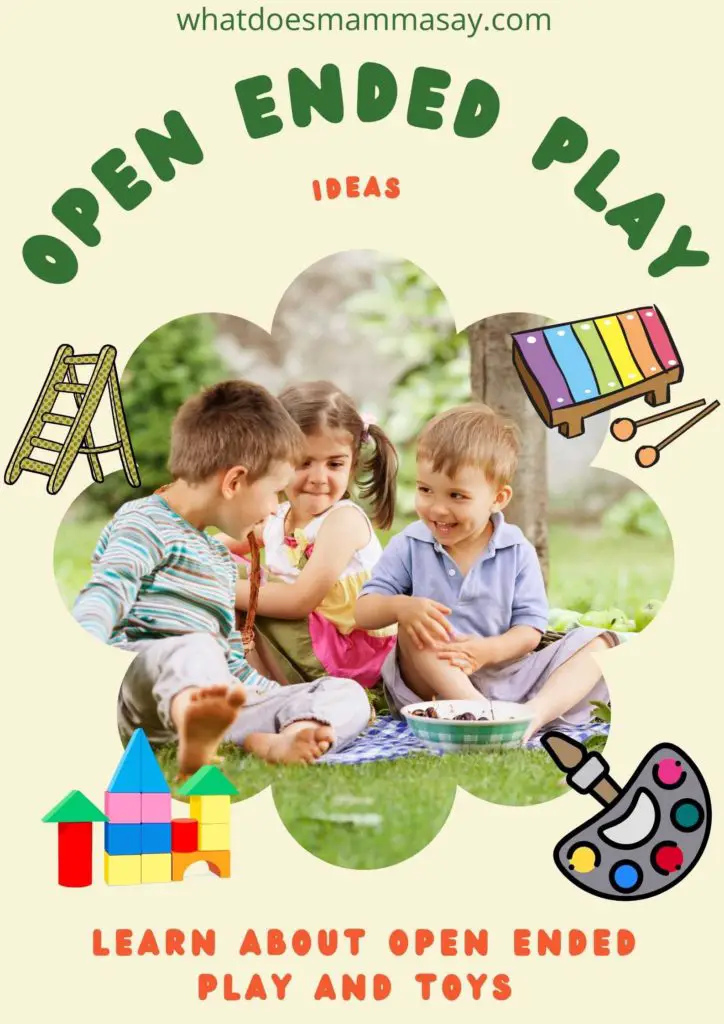
For example, the presence of grass, trees and cliffs have a stimulating effect on children and invite particular bodily movements. Also, consider that children under the age of 6 are unable or find it difficult to follow structured activities when playing.
That is why children younger than 6 will spend their time engaged in spontaneous, open ended play. This is unstructured and allows for short bouts of activity.
Because children tend to be most active when outdoors, make sure you provide children with plenty of outdoor opportunities that stimulate play. Research found that free, bodily and dispersed play are the main characteristics of outdoor play. Let’s look at each one in more detail.
Main characteristics of outdoor open ended play
As mentioned above, open ended play is characterised by three main attributes:
free
bodily
dispersed
Free play has no structure and the child is completely in charge of the play episode. Free play is the most predominant type of play for young children. It can include parents as well as long as they don’t insist on rules and predetermined goals. However, what adults could do is make sure to offer things which can be easily manipulated and rearranged.

Bodily play is described as involving all the body and large muscles. It is about the energy used, but also the variety of bodily movements. The best outdoor open ended play environment should include obstacles that children can jump over. It could also include objects which can be lifted and moved around. Plenty of surfaces to run on. All these will help children’s balance, locomotion, manipulation, projection and flight.
Dispersed play refers to play that can be taken outside the boundaries of a dedicated play space. In doing so, children are allowed to explore and expand their play.
Using loose parts as part of outdoor play could help with this. Loose parts play allows children to move, transport and manipulate them over a large area. Anji Play is a great example of using loose parts for outdoor open ended play.
Another idea could be deciding on a destination point and exploring different pathways to follow across a landscape.
Conclusions
Research found that as free open ended play dropped, paediatric problems occurred. So outdoor open ended play may serve as the perfect opportunity for children to engage in physical activity.
What is more, open ended play enables children to invent, resolve unpredictable problems. Find innovative ways of looking at things, establish new patterns and so much more.
So, it seems obvious that open ended play offers great benefits to children. They only need the opportunities to play freely!
You can offer those opportunities!
References
Tschampl, Michael. (2014). Interaction Design Strategies for Open-ended Play.
Boon, Boudewijn, Rozendaal, M.C, Van Den Heuvel-Eibrink, Marry M, Van Der Net, J.J, Van Grotel, M, and Stappers, P.J. (2020). “Design Strategies for Promoting Young Children’s Physical Activity: A Playscapes Perspective.” International Journal of Design, 14 (3).
Bondi, Damiano, & Bondi, Danilo. (2021). “Free Play or Not Free Play: An Interdisciplinary Approach to Deal with Paradoxes.” Creativity Research Journal, 33 (1), 26-3.

Hi. I am Monica, an experienced ESL teacher and early years student, mother to a preschooler and passionate reader.

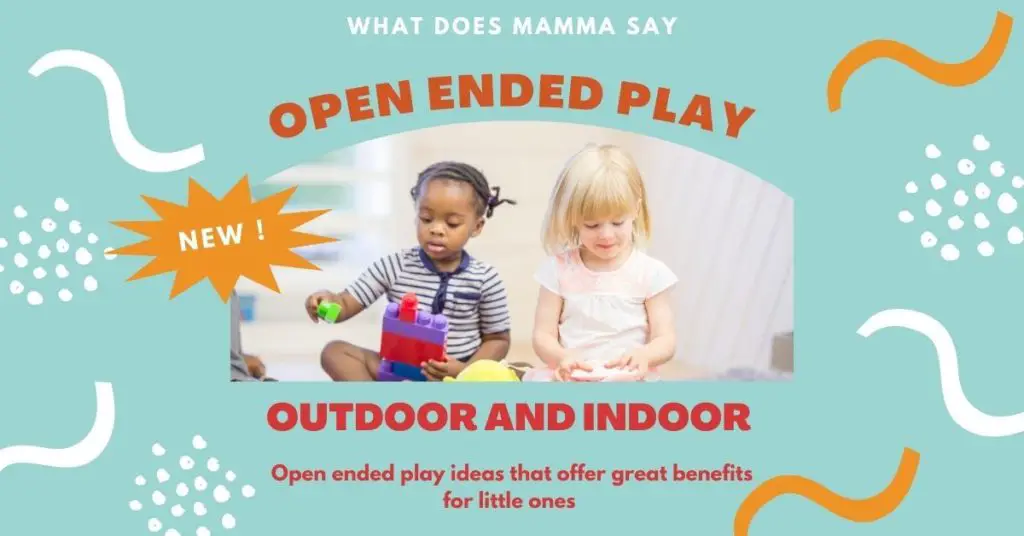
I love this article. It gives a totally different perspective than most activities post. We’ll definitely try the different indoor corners.
This is such a helpful post. Saving a bunch of these try play with my daughter, open ended play is always a hit!